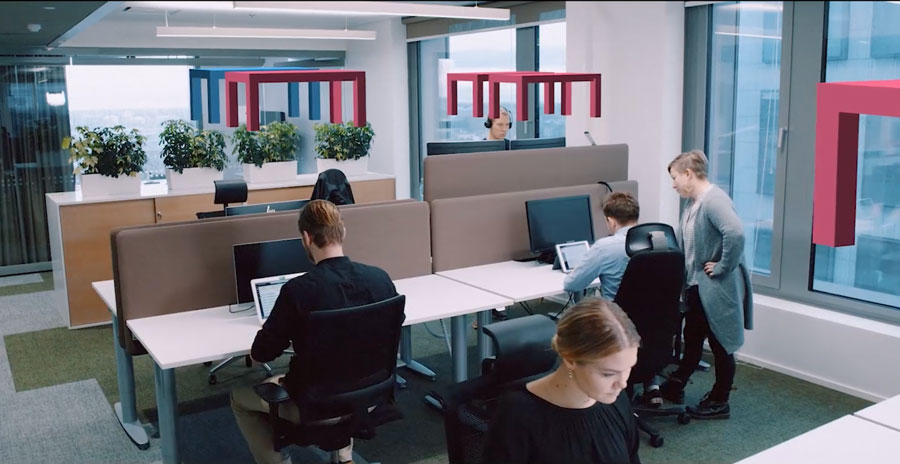No one size-fits-all approach to workplace design
I really enjoyed reading the recent Washington Post article entitled “What We Learned About Hybrid Work in 2022”. Some of the main points align with what I have learned from talking to Empathic Building customers on recent trips to the UK and to Germany. A recurring theme has been that it is unrealistic to think that we will find a “one-size-fits-all” strategy for a company’s modern working practices. This could be in relation to the number of days working remotely per week or in relation to workplace design. Either way companies need to learn what works for their individual employees, teams and departments.
The Washington Post article also has some quotes from Stanford Professor, Nicholas Bloom, who talks enthusiastically about experimentation. He states that experimentation is the most striking part of the last 12 months. The article goes on to say that “we have learned a lot from our experiments this year, but companies are still in the early days of determining what works best for them”.
Large organizations will often require different approaches from department to department. We could indulge in stereotypes and consider a dynamic marketing department versus a conservative research and development department for example. They also require different approaches from country to country too. Let’s contemplate the different strategies that would be most suitable for Mexico City or Munich or Milan.
Some of the workplace design decisions that can be understood better through experimentation are as follows:
Desk booking
During the pandemic many companies introduced desk booking software and this made sense when offices were only allowed to be sparsely occupied. For example some companies only allowed a maximum utilisation of 50% and thus it was important to book a desk in advance to make sure that the 50% threshold was not exceeded. Employees were happy to book in advance as there was a chance that there would not be enough space for them and the potential poverty of space provided that motivation. However, at the moment most office buildings are very lightly occupied and many employers have removed restrictions on the maximum number of people. Thus, there is less incentive for employees to book in advance. Experimentation in the area of desk booking is often done in two ways.
Zero click booking:
Employees can be given the option of booking desks via sensors with zero click booking. This is a very quick to learn and quick to use approach. The employees see which desks are currently available via an application, such as Empathic Building, which can be on a phone, laptop or wall mounted info screen. They can then sit at an available desk and the sensor will change it to be shown as unavailable. It will be booked for that person for as long as they are sitting at the desk. If they leave temporarily, it will remain booked for a couple of hours after they have last sat there.
Two click booking:
Employees can also book the desks in advance by clicking on the available desks in the application and booking it for the required time period.
Summary: Zero click booking is quick to use and simple to learn and suits employees who just want to turn up to the office and grab a desk. Two click booking requires the employee to be more active but it gives them the emotional comfort of knowing that they are guaranteed a particular desk before they arrive at the office.

Departmental workplace design strategy:
Another thorny decision is related to activity-based working versus departmental home zones. Experimentation in these areas is often done as follows:
Activity-based working:
Dynamic and more open cultures will be more suited to activity-based working which allows employees to choose from a variety of different working areas depending on the tasks at hand. The areas might include desks in focus rooms or collaboration zones or noisy coffee areas for example.
Departmental home zones
However, more conservative departments may want departmental home zones where the department is assigned to an area that is just for them. The design of this area will be similar to conventional workplace design of desks for focus work and then a selection of rooms for meetings, calls and collaboration.
Summary: organizations can experiment with these designs for a temporary period of time such as 3 months and receive feedback from different departments and cultures. Having a smart building application such as, Empathic building, allows the employees to clearly understand the workplace design by seeing all the different areas on the interactive digital twin. For example, employees can see or search for different activity zones such as the “silent room” or to search for departmental home zones such as the “human resources team”.
From our experience with large international customers the main targets over the next year should be to experiment and to learn. The first step is to accept that there won´t be a “one-size-fits-all” strategy and the second is to start experimenting to understand what works for the different interorganizational cultures. Organisations can then start to measure how much space is needed, how to decide on desk booking and departmental workplace design strategies. The end goal is to develop a flexible but robust long term strategy built on data.
In conclusion, the modern working practices of a company can vary greatly and it is unrealistic to find a single strategy that works for all. Experimentation is key in determining what works best for each individual company and its employees, teams, and departments. Different departments and countries may require different approaches, such as activity-based working versus departmental home zones. Desk booking methods such as zero-click or two-click booking can also vary depending on the company culture. The goal is to experiment and learn, using data to develop a flexible but robust long-term strategy for workplace design. Empathic Building is a smart building application that can help organizations understand and visualize their workplace design options.


